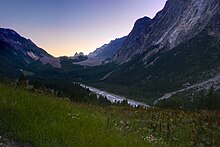Miage Glacier: Difference between revisions
m moved Miage glacier to Miage Glacier: caps |
No edit summary |
||
| Line 1: | Line 1: | ||
'''Miage Glacier''' is a [[debris]]-covered [[glacier]] in northwestern [[Italy]]. It is situated on the southwest flank of the [[Mont Blanc Massif]], flowing from [[Col de Bionnassay]] (3892m [[above sea level]]) into [[Val Veny]] in the extreme northwest of Italy. It is Italy's longest glacier at a length of roughly 10km and the largest debris-covered glacier in Europe.<ref>{{cite doi|10.1191/0959683605hl809rr}}</ref> Approximately 5km<sup>2</sup> of its total area of ~11km<sup>2</sup> is covered in debris originating primarily in [[rockfall]] from surrounding walls<ref>{{cite doi|10.1016/j.quascirev.2008.09.025}}</ref> and [[avalanching]] in accumulation areas of its four [[tributaries]].<ref>{{cite doi|10.1016/j.coldregions.2007.03.004}}</ref> Debris carried along within the glacier, however, is also being exposed at accelerating rates due to accelerating thinning of the glacier tongue.<ref>{{cite doi|10.1016/j.coldregions.2007.03.004}}</ref> The number of sources of supraglacial debris as well as the unusual, [[mica schist]]-dominated [[lithology]] of the rock walls surrounding the glacier, makes for a varied debris lithology; debris cover becomes continuous at ~2400m [[above mean sea level|asl]] and remains unbroken to the [[terminus]]. Patchy areas can occur, however, where [[crevasses]] or [[moulins]] occur.<ref>{{cite doi|10.1029/2009JD013224}}</ref> Debris thickness generally increases from a few cm at 2400m asl to over 1m at the terminus at ~1775m asl, although the spatial distribution of thicknesses is inhomogenous especially on parts of the northern terminal lobe. |
'''Miage Glacier''' is a [[debris]]-covered [[glacier]] in northwestern [[Italy]]. It is situated on the southwest flank of the [[Mont Blanc Massif]], flowing from [[Col de Bionnassay]] (3892m [[above sea level]]) into [[Val Veny]] in the extreme northwest of Italy. It is Italy's longest glacier at a length of roughly 10km and the largest debris-covered glacier in Europe.<ref>{{cite doi|10.1191/0959683605hl809rr}}</ref> Approximately 5km<sup>2</sup> of its total area of ~11km<sup>2</sup> is covered in debris originating primarily in [[rockfall]] from surrounding walls<ref>{{cite doi|10.1016/j.quascirev.2008.09.025}}</ref> and [[avalanching]] in accumulation areas of its four [[tributaries]].<ref>{{cite doi|10.1016/j.coldregions.2007.03.004}}</ref> Debris carried along within the glacier, however, is also being exposed at accelerating rates due to accelerating thinning of the glacier tongue.<ref>{{cite doi|10.1016/j.coldregions.2007.03.004}}</ref> [[File:Miage Glacier Sunset.jpg|thumb|Miage Glacier at sunset, as seen from eastern Val Veny in August 2010]] <br /> |
||
The number of sources of supraglacial debris as well as the unusual, [[mica schist]]-dominated [[lithology]] of the rock walls surrounding the glacier, makes for a varied debris lithology; debris cover becomes continuous at ~2400m [[above mean sea level|asl]] and remains unbroken to the [[terminus]]. Patchy areas can occur, however, where [[crevasses]] or [[moulins]] occur.<ref>{{cite doi|10.1029/2009JD013224}}</ref> Debris thickness generally increases from a few cm at 2400m asl to over 1m at the terminus at ~1775m asl, although the spatial distribution of thicknesses is inhomogenous especially on parts of the northern terminal lobe. |
|||
==References== |
==References== |
||
Revision as of 20:20, 13 September 2010
Miage Glacier is a debris-covered glacier in northwestern Italy. It is situated on the southwest flank of the Mont Blanc Massif, flowing from Col de Bionnassay (3892m above sea level) into Val Veny in the extreme northwest of Italy. It is Italy's longest glacier at a length of roughly 10km and the largest debris-covered glacier in Europe.[1] Approximately 5km2 of its total area of ~11km2 is covered in debris originating primarily in rockfall from surrounding walls[2] and avalanching in accumulation areas of its four tributaries.[3] Debris carried along within the glacier, however, is also being exposed at accelerating rates due to accelerating thinning of the glacier tongue.[4]

The number of sources of supraglacial debris as well as the unusual, mica schist-dominated lithology of the rock walls surrounding the glacier, makes for a varied debris lithology; debris cover becomes continuous at ~2400m asl and remains unbroken to the terminus. Patchy areas can occur, however, where crevasses or moulins occur.[5] Debris thickness generally increases from a few cm at 2400m asl to over 1m at the terminus at ~1775m asl, although the spatial distribution of thicknesses is inhomogenous especially on parts of the northern terminal lobe.
References
- ^ Attention: This template ({{cite doi}}) is deprecated. To cite the publication identified by doi:10.1191/0959683605hl809rr, please use {{cite journal}} (if it was published in a bona fide academic journal, otherwise {{cite report}} with
|doi=10.1191/0959683605hl809rrinstead. - ^ Attention: This template ({{cite doi}}) is deprecated. To cite the publication identified by doi:10.1016/j.quascirev.2008.09.025, please use {{cite journal}} (if it was published in a bona fide academic journal, otherwise {{cite report}} with
|doi=10.1016/j.quascirev.2008.09.025instead. - ^ Attention: This template ({{cite doi}}) is deprecated. To cite the publication identified by doi:10.1016/j.coldregions.2007.03.004, please use {{cite journal}} (if it was published in a bona fide academic journal, otherwise {{cite report}} with
|doi=10.1016/j.coldregions.2007.03.004instead. - ^ Attention: This template ({{cite doi}}) is deprecated. To cite the publication identified by doi:10.1016/j.coldregions.2007.03.004, please use {{cite journal}} (if it was published in a bona fide academic journal, otherwise {{cite report}} with
|doi=10.1016/j.coldregions.2007.03.004instead. - ^ Attention: This template ({{cite doi}}) is deprecated. To cite the publication identified by doi:10.1029/2009JD013224, please use {{cite journal}} (if it was published in a bona fide academic journal, otherwise {{cite report}} with
|doi=10.1029/2009JD013224instead.
